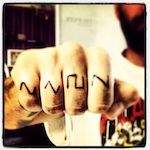| Author
|
The Mother of all BASSLINES thread
|
Ellon
IsraTrance Full Member

Started Topics :
56
Posts :
1223
Posted : Aug 31, 2013 14:57
|
|
Nectarios
Martian Arts

Started Topics :
187
Posts :
5292
Posted : Aug 31, 2013 15:04
|
|
Nectarios
Martian Arts

Started Topics :
187
Posts :
5292
Posted : Aug 31, 2013 15:58
|
Also bare in mind that a VST/AU editor is in the works for the Minitaur...not that you need one with such a simple synth, but yeah sometimes its cool to recall a channel strip setting with the synth patch and all inserts/sends, in your DAW.
       
http://soundcloud.com/martianarts |

|
|
frisbeehead
IsraTrance Junior Member
Started Topics :
10
Posts :
1352
Posted : Sep 1, 2013 00:07
|
Quote:
|
On 2013-08-31 14:47, Nectarios wrote:
It was by chance that I started talking with Amos, he just happens to like some of my tunes and was looking for someone who was using his products for something other than '70s prog rock solos  to test new firmwares in the Minitaur. to test new firmwares in the Minitaur.
The envelopes on the Minitaur and the Sub Phatty are digital. They do the job just fine, yet they are not as punchy as a CEM3310 envelope (Roland SH-101, Doepfer ADSRs...etc...etc).
The Little/Slim Phatty envelopes are analog and sound punchier for sure.
But if you want to write steady 16th basslines with the Slim Phatty, you are entering a world of sampling, as the Little/Slim Phatty does not have VCO phase re-trigger.
There are only 3 knobs on the envelope section on the Minitaur but there is a Release button that you hold down and the Decay knob switches into the Release parameter. Does the job well.
|
|
I guess I'm glad that they've decided to go with digital envelopes then, since it provides instant usage for Bass sounds with the warm Moog filter on it. wouldn't miss the editor much on such a direct synthesizer, but yeah, being able to recal exact settings is always good 
how well does it do acid stuff? teebee like sounds? |

|
|
Nectarios
Martian Arts

Started Topics :
187
Posts :
5292
Posted : Sep 1, 2013 11:24
|
|
frisbeehead
IsraTrance Junior Member
Started Topics :
10
Posts :
1352
Posted : Sep 1, 2013 16:10
|
Quote:
|
On 2013-09-01 11:24, Nectarios wrote:
Quote:
|
On 2013-09-01 00:07, frisbeehead wrote:
how well does it do acid stuff? teebee like sounds?
|
|
Sorry there is no bass in the sound as I shot this with the iphone.
Acid sounds have a lot to do with teh sequencing, so this is my x0xb0x triggering the Minitaur. It sounds nothing like a 303, yet its a completely different flavor.
|
|
yeah, that's good enough! thank you! different flavor all right, very cool one! I get somewhat similar sounds with the Virus with the Analogue filters (that try hard to emulate precisely what you have there XD)...
but I guess you got me with the phase retrig thing! I'm sold! the filter sounds indeed awsome!
|

|
|
Ryu-X
IsraTrance Junior Member

Started Topics :
21
Posts :
74
Posted : Sep 1, 2013 20:19
|
|
frisbeehead
IsraTrance Junior Member
Started Topics :
10
Posts :
1352
Posted : Sep 1, 2013 21:07
|
Quote:
|
On 2013-09-01 20:19, Ryu-X wrote:
Thank you Nectarios for all the tips !!
I was able to activate VCO Gate Reset properly in the Shift Menu.. also i found a way to get a decent bassline on high BPM (185) out of it, now its just the practice i need with the moog to achieve what i am looking for 
One problem still:
http://soundcloud.com/ryu-x/nn-185-just-started
My Bassline always rolls along with the kick but is not really glued to it.. i tried endless Kick length, Bass length and ADSR combinations.. but listening to paralocks bassline it seems the notes are sticking together in harmony.. here a little example of what i am talking bout:
http://www.youtube.com/watch?v=cpJ2rNUFjOg
Is it all EQ/compressing or what do you guys think ?
Thanks
|
|
the kick and bass must really compliment each other. bass notes need to be short, adjust the placement by a couple of notches if needed. gently EQ the sum/group with an analogue modeled EQ - like a Neve emulator or something (unless you have the real deal that is XD). bus compressor can work to, sometimes, all of this with very gentle settings!!
if you're using a sidechain compressor, the release must be super fast, like 7-8ms (check how long it takes for a 16th note on your choosen bpm, but always use the ears of course). all a matter of fine tunning really! |

|
|
Prakul

Started Topics :
1
Posts :
49
Posted : Oct 2, 2013 19:51
|
okay ive been trying to make a bassline Ryu-X is talking about, pretty fast bpm (around 175ish) and after reading and reading all the valuable information on this forum i finally got Bazzism for kicks and i use Sylenth1 for my bass.
Here's where i am right now after several tries of EQing, sidechain, multiband compression, ADSR combinations :
http://www.2shared.com/audio/nMe9B7l2/bassline.html
(PLEASE DONT CLICK ON THE BIG DOWNLOAD BUTTON IT WILL LEAD YOU TO SOME iLivid bullshit CLICK ON THE SMALL DOWNLOAD BUTTON BELOW) sorry for the caps
its a really small file only 3 seconds around 400 kb or something so please check it out.
im looking for a powerful bassline such as https://soundcloud.com/paralocks/paralocks-solar-power
the kick and bass sounds like one element and the bassline sounds so tight even at a high bpm and thats what im looking for
would be really greatful if someone can help me out 
thanks in advance |

|
|
zwarag
IsraTrance Junior Member

Started Topics :
14
Posts :
80
Posted : Oct 3, 2013 16:17
|
a friend and me tryed to do some high bpm stuff last weekend.
Kick: i would suggest you do the vsweep a bit shorter and eq the lower basses a bit out
or increase the hz where it has to end.
for the bass, i would take a normal fullon baseline, cut everything above ~400hz away and put a nice distorted synth on top of that bass, if you got this -> bounce (we felt bouncing improoved the listeing A LOT).
Then do some eq and compression. but the point is, doing the bass with 2 synths brought us quite fast to what we expected and it was quite like what you'd like to do.
|

|
|
Hypereal

Started Topics :
5
Posts :
86
Posted : Oct 19, 2013 23:20
|
Bass Secrets - Mixing Bass 2
Practical E.qing - in the Context of Kick and/or Bass lines
First the bad news: there is no recipe for how to e.q a bassline. One cannot just say, "just boost x frequency by x db, or cut y frequency by x db and it'll sound great."
Why? Because it depends on the unique properties the kick you're using (mainly it's frequency content and length), the bassline note lengths, the key of the bass line, the bass sound and waveform and the bass level relative to the kick.
You have to listen to see how they interact against each other. This makes it an art rather than a science. Hence the importance of being able to actually hear what you are doing. Once you can hear what's going on, then you can begin the process of training your ears to focus upon hearing low frequency detail and start improve your mixing skill.
Second thing to bear in mind is this: If you want to have a huge and chunky bottom end on you tracks then you must either (and somewhat counter-intuitively) skinny up the bassline or the kick by reducing or removing the subs with e.q. It's either one or the other, but not both.
Both kick and bassline cannot be rich in sub-bass and co-exist in the same track at the same time. Or rather they can, but you'll end up with a boomy and indistinct result. I've known this in theory for longer than I care to admit, but that didn't stop me for most of my record making life from trying to have both the the bassline and the kick be fat and chunky at the same time, but I've eventually been dragged kicking and screaming to the conclusion that it just doesn't work.
What I've discovered by my own experimentation is that the lower you go in terms of frequency, the more problematic getting two low frequencies to co-exist becomes, to the point where, for practical purposes, only one low frequency can exist at any one time. It's a two cats in a sack situation or like two heavyweight boxers, they both cannot exist in the same ring at the same time and both be champion, there's always a fight and it's often ugly.
E.Q filters for Kick and Bass
I'm assuming that you know the difference between e.q types such as low pass, high pass etc. If not then a quick Google should bring you up to speed.
Bass shelving filter:
Bass shelves in today's plugins can often be unneccesarily complex and confusing offering several different design types ( Bessel, Gurzon, Butterworth etc.) as well as variable Q and variable filter "corner" (cutoff point).
Personally I find this counter productive.
It takes hours of practical experience with a particular e.q. shelf to become aquainted with how it affects different sounds. As an example, back in the day when I used to mix through an analogue console, I found that by using the simple 80 hz low shelf combined with the 18db/oct high pass switch and the semi-parametric low mid control which swept down to 50 hz I could find huge amount of low end shaping possibilities.
Having limitations often helps the one's creativity and ironically, infinite possibilities can actually be a hindrance by aggravating option anxiety as well as the sheer amount of time wasted by auditioning and experimenting with different filter types on each new plug-in.
(btw Bagginz Law bears repeating here. Bagginz Law states that: "The quantity of finished work leaving a producers studio is inversely proportional to the amount of plugins in that producer's plugin folder").
Given this situation, when it comes to learning how to use low shelving e.q, a good approach (and one that I often use) is to leave the Q at default, and set the frequency at 100 hz (if it's not already at 100 hz by default) and simply use the cut and boost control. Also stick to using a plugin that you're familiar working with. Later you can gradually start to use the other controls once you build up a working relationship with how it sounds and what it does.
I find bass shelves really useful to raise or lower the amount of low frequencies by varying amounts. I often end up with small cuts or boosts around < 3db, which is usually a lot if you are affecting that large a range of frequencies.
High Pass (or low cut)
High pass filters are useful for removing low frequencies altogether, rather than just reducing them.
In this context, setting a steep high pass (24db/oct or more) on a bassline channel set very low - around 20 - 35 hz can help to remove subsonics that are otherwise just eating up headroom.
Before you say "but my monitors only go down to 40hz" try it and listen. ( pro monitors quote their low frequency limit as the -3db down point, so they actually do reproduce frequencies below that.)
The effect of filtering out the ultra low subs is actually perceivable and depending on what type of filter and how steep the slope the effect, the result can be really quite pronounced.
Removing some ultra low frequencies which are mainly below the range of the monitors perversely can actually make the volume rise on the channel meters. I'm not exactly why it happens technically, but believe that it has to do with low frequency masking or phase cancelling effects.
Certainly when combining a nice kick together with the bassline channel which has had the ultra low frequencies removed, the end result is two parts tending to lock together a lot better as it minimizes the sub frequencies in each part "fighting" with each other usually by part phase-cancelling each other out. Therefore allowing the kick's subs to breathe.
Bottom line is: removing the unwanted subs from the bassline give more headroom and allows the subs in the kick sound unrestrictedly. You may want to combine this sub cut with a low shelf to reduce the low end a little - again it depends on the sound.
You can of course do it the other way around, by skinnying up the kick instead which I've done myself in several Trance tracks, (and which would be a better approach for say Dub music) but generally speaking I prefer to let the kick carry the sub in Trance.
Parametric Filter
Here's a good tip for how to zero in on frequencies using parametric e.q.s
1. Solo your channel
2. Dial up a large boost (say 8- 12 db) with a narrow q.
3. Now sweep around while listening to find the frequency that you would like to either cut or boost.
4. Once you've found the frequency, then either cut it by lowering the gain to a negative amount or lower the boost amount of that frequency to a smaller amount.
5. Unsolo your channel to place the sound back into it's musical context.
6. Switch the e.q out and back in again to give yourself a reality check as it's very easy to get quickly accustomed to a processed sound. Again, it's important to make any evaluations while it is in the mix, and not while it is in solo mode. Does it sound better? Or not?
On the Kick:
Here's a couple of useful tips for the e.q on the Kick.
1. A small boost with a medium q at around 4 khz will emphasise the "click" of the kick to allow it to not get buried in the mix.
2. If a kick needs some "punch" then a small boost with medium q centred around 120hz - 250hz will give some body. This frequency band gives the kick punch and drive (which often can be what's required) without adding problematic lows.
3. If a kick need some sub added or removed, use the parametric e.q. A low shelf is a bit too crude a tool for this kind of work. Using the parametric tip above, zoom exactly in on the area which needs treatment. Fairly narrow q often works best. You'll need to be precise with the low frequencies because in the dark netherworld of the sub regions, just going from 40 hz - 80 hz is a whole octave. If you find yourself having to boost the low end with a low shelf, then it maybe best to use another kick sample, unless of course you don't have anything better, in which case carry on.
On Bass lines:
With regard to e.q ing the bass line, once you have your basic kick and bassline levels set, don't be afraid to notch out some of the mids with a parametric if you think it sounds better, or you want to make some room in the midrange for other lead stuff.
Conversely don't be afraid to boost away on a parametric band (or two) if it will help give your bassline some definition and help it sit better in the mix.
It's not like the raw saw wave bass sound has to be kept natural.
Obviously you must do your e.q ing of the bassline when the the kick is playing along together with the bass.
E.q.ing the kick and bass group:
Another tip is to e.q the kick and bass group together. I haven't used this for a while but I've used this technique in the past. This can make the kick and bass sound more cohesive. I routinely route my kick and bass to a single group (a buss in Logic speak)
This enables me to apply any processing (filtering effects, e.q.ing, compress, limiting etc. ) to both at once should I so wish. Sending both kick and bass to their own group is a useful habit to get into. I recommend setting up your sequencer template with the routings already in place.
- Billy Cosmosis |

|
|
supergroover
IsraTrance Junior Member

Started Topics :
39
Posts :
1505
Posted : Jan 4, 2014 17:22
|
Is there any reason why a bass shouldn't use unison?
        soundcloud.com/supergroover soundcloud.com/supergroover |

|
|
frisbeehead
IsraTrance Junior Member
Started Topics :
10
Posts :
1352
Posted : Jan 4, 2014 19:39
|
Quote:
|
On 2014-01-04 17:22, supergroover wrote:
Is there any reason why a bass shouldn't use unison?
|
|
no, unless you're using the spread and detune on that unisson, in which case you'd get phasing and stereo width down there that's always hard to tame deep down.
remember, unisson is not just doubling the sound as it is on the output, it's doubling the entire chain...
sounds good on some instruments, like Virus and Massive for example. but don't feel like it's much needed imo. |

|
|
Padmapani

Started Topics :
2
Posts :
431
Posted : Jan 5, 2014 06:54
|
|
if you have a seperate sub layer then there's imho no reason not to use unison on the upper parts if it sounds good (even with spread and detune). |

|
|
frisbeehead
IsraTrance Junior Member
Started Topics :
10
Posts :
1352
Posted : Jan 5, 2014 18:06
|
Quote:
|
On 2014-01-05 06:54, Padmapani wrote:
if you have a seperate sub layer then there's imho no reason not to use unison on the upper parts if it sounds good (even with spread and detune).
|
|
indeed. even distortion/saturation and stereo effects, everything goes. |

|
|
|